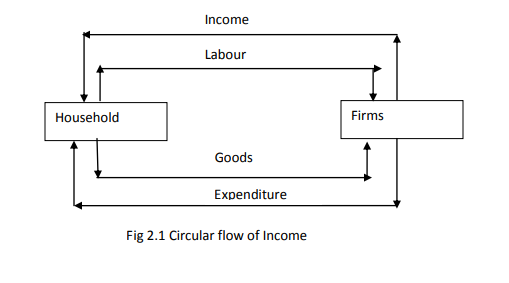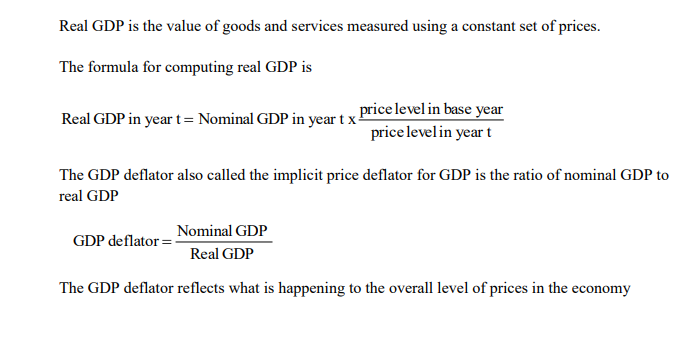National Income Accounting refers to the measurement of aggregate economic activities, particularly national income and its components. GDP is often considered the best measure of how well the economy is performing. The goal of GDP is to summarize in a single number the monetary value of economic activity in a given period of time. The value of final output produced in a given period, measured in the current prices is referred to as Nominal GDP.GDP per capita relates the total value of annual output to the number of people who share that output; it therefore refers to the average GDP per person. It is commonly used as a measure of a country‘s standard of living. However GDP does not; tell us what portion of output every citizen is getting. There are two ways to view this statistic:
One way to view GDP is the total income of everyone in the economy.
Another way to view GDP is as the total expenditures in the economy .Consider the following two sector economy.

Imagine an economy that produces single good, bread, from a single input labour. The above figure illustrates all the economic transactions that occur between households and firms in this economy. The inner loop represents the flow of bread and labour (expenditures). The households sell their labour to the firms and the firms use the labour to produce goods and services, which in turn they sell to the households. The outer loop represents the corresponding flow of shillings (incomes). The households buy bread from the firms.
The firms use some of the revenue generated from the sale of bread to pay workers and the remainder is the profit which belongs to the owners of the firms. The two loops combined in the above figure gives us what is referred to the Circular flow of income.
2.2 The components of Gross Domestic Product:
The National income accounts divide GDP into four broad categories of spending.
Consumption: Consists of the goods services bought by households. It is divided into three subcategories: non-durable goods, durable goods and services.
Investment: Consists of goods bought for future use.
Government Purchases: are the goods and services bought by the state, and local governments. This includes such items as military equipment, highways, and the service that government workers provide.
Net exports: Takes into account trade with other countries. Net exports are the value of goods and services exported to other countries minus the value of goods and services that foreigners provide us. Net exports represent the net expenditure from aboard on our goods and services, which provide income for domestic producers. In other words it is exports (X) minus imports (M).
A closed economy has three uses of goods and services it produces. These three components are expressed in an equation as follows.
Y = C+ I+ G
This equation is an identity. It must hold because of the way the variables are defined. It is called a national income accounts identity.
Real GDP vs. Nominal GDP

Measuring the standard of living
A shilling today does not buy as much as it did 20 years ago. The cost of everything has gone up. The increase in overall prices called inflation and is one of the primary concerns of economists and policy makers. The most commonly used measure of the level of prices is the CPI. This is the price of a given basket of goods and services relative to the price the same basket in some base year
2.3 CPI vs GDP Deflator
There are key differences between the two measures
1) GDP deflator measure the prices of all goods and services produced, where the CPI measures the prices of only the goods and services bought by consumers. Thus an increase in the price of goods bought by firms on the government will show up in the
GDP deflator but not in the CPI
2) GDP deflator includes only those goods produced domestically .imported goods are not part of GDP and do not show up in the GDP deflator. Hence an increase in the price of a Toyota made in Japan and sold in this country affects the CPI, because the Toyota is
bought by consumers, but it dies not affect the GDP deflator
3) The CPI assigns fixed weights to the prices of different goods, whereas the GDP deflator assigns changing weights .In other words, the CPI is computed using a fixed basket of goods whereas the GDP deflator allows the basket the basket of goods to change over time